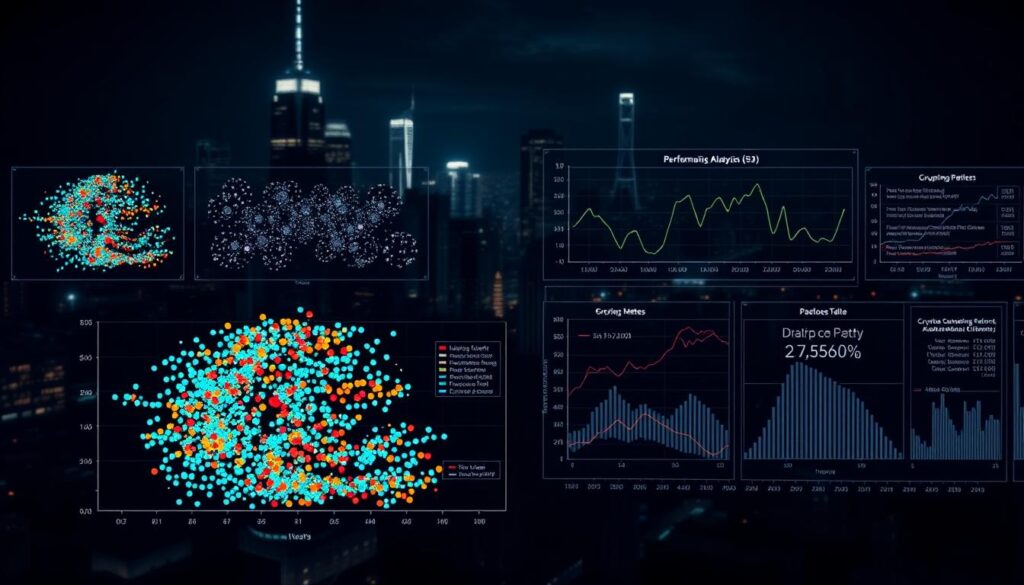Now Reading: Machine learning cryptocurrency clustering analysis Explained
- 01
Machine learning cryptocurrency clustering analysis Explained
Machine learning cryptocurrency clustering analysis Explained

The digital asset landscape is vast and complex. New tools are essential for making sense of it all. This guide explores a powerful method that brings clarity to the crypto world.
By examining years of information, this approach identifies hidden patterns among thousands of digital coins. It combines computer science with financial theory. The goal is to provide actionable insights for investors and researchers.
This technique has evolved from simple correlation studies to advanced methods. It helps tackle major challenges like extreme price swings and the need for smart diversification. The focus is on data-driven strategies to navigate market unpredictability.
Our discussion covers the technical foundations, grounded in real-world applications. We synthesize findings from academic research and practical use cases. You will see how this methodology informs smarter investment decisions.
Key Takeaways
- This method transforms how we understand digital asset markets by finding patterns.
- It uses historical data to reveal connections between different cryptocurrencies.
- The approach combines computer science, finance, and blockchain technology.
- Techniques have advanced from basic correlation to sophisticated grouping methods.
- It addresses core investment challenges like volatility and the need for diversification.
- The foundation includes network modeling and community detection algorithms.
- Insights are drawn from both academic research and practical, real-world applications.
Introduction to Machine Learning Cryptocurrency Clustering Analysis
Digital assets have fundamentally reshaped investment strategies by offering novel opportunities beyond conventional markets. Since Bitcoin’s introduction in 2009, the financial landscape has evolved dramatically with thousands of digital currencies emerging.
Traditional financial tools often struggle with the unique characteristics of blockchain-based currencies. This created a pressing need for more sophisticated approaches to understand market dynamics.
Setting the Stage for Trend and Report Insights
Advanced methodologies emerged to group digital assets based on shared patterns in price movements and trading behaviors. These grouping techniques help investors identify relationships that might otherwise remain hidden.
Academic studies have demonstrated how these approaches can uncover stable patterns despite market unpredictability. The research draws from years of real-world information to build reliable frameworks.
This foundation enables smarter portfolio construction and risk management strategies. Investors can make more informed decisions by understanding how different digital currencies behave together.
Overview of Cryptocurrency Markets and Blockchain Technology
Blockchain technology serves as the bedrock for the entire digital asset ecosystem. This system is a decentralized ledger that records all transactions across a distributed network of computers.
It operates without a central authority, like a bank. This fundamental shift enables peer-to-peer exchanges on a global scale.
Understanding Decentralization and Volatility
Bitcoin pioneered this decentralized model. Its success sparked the creation of thousands of alternative digital assets, often called altcoins.
Each contributes unique features and sentiment to the complex market. This diversity is a key characteristic of the space.
However, this new structure brings significant challenges. Price swings in this market are far more extreme than in traditional stocks.
Research indicates a high degree of unpredictability in asset price movements. This volatility is a defining feature.
The underlying blockchain networks rely on distributed nodes to validate transactions. This ensures security and transparency.
Understanding these technical foundations is crucial for any meaningful analysis. Network behavior directly influences market dynamics.
Historical data reveals growth in institutional adoption despite these risks. This underscores the evolving role of digital assets.
The unique traits of these markets create specific opportunities and challenges:
- 24/7 global trading accessibility
- Rapid pace of technological innovation
- Need for advanced methods to find stable patterns
These factors make sophisticated analytical approaches essential for navigating the landscape effectively.
Historical Development of Cryptocurrency Trends
The timeline of blockchain-based currencies reveals distinct phases of adoption, each marked by significant technological and market developments. This evolution spans from Bitcoin’s 2009 introduction to today’s complex digital asset ecosystem.
During the early period from 2009 to 2013, Bitcoin remained a niche technology. It was primarily understood by cryptography enthusiasts with limited mainstream recognition. The market capitalization during this time was minimal compared to today’s standards.
The period from 2013 to 2017 witnessed explosive growth in cryptocurrency markets. Thousands of alternative digital assets emerged alongside increasing institutional interest. This era culminated in the 2017 bull market that brought widespread public attention.
Academic research intensified between 2015 and 2018, examining network topology and price prediction models. Data collection methods became more sophisticated, spanning longer time frames. Studies evolved from weeks to continuous 12-month analysis periods.
Historical price trends reveal recurring boom-and-bust cycles across different time periods. These patterns provide rich datasets for understanding market behavior. The evolution shows increasing sophistication in both trading infrastructure and analytical methodologies.
Understanding Machine Learning in Financial Applications
A branch of artificial intelligence is revolutionizing how we interpret complex financial datasets. These systems learn from information to improve their performance on specific tasks. This capability is especially valuable for navigating volatile markets.

An Introduction to Learning Algorithms and Data Analytics
At the core of these applications are sophisticated learning algorithms. They can be broadly categorized into different types. Supervised methods learn from labeled historical data. Unsupervised techniques find hidden patterns in information without pre-defined labels.
Another approach involves systems that learn optimal strategies through trial and error. These methods excel at processing vast amounts of market data. They identify trends and assess risk far beyond human capacity.
A critical step is feature extraction. Raw data like prices and volumes must be transformed into meaningful features. This process allows the algorithm to perform accurate prediction and classification.
Traditional models have served as benchmarks for decades. Newer, more complex models are now being compared against them. The evolution is driven by greater computational power and more sophisticated data analysis.
Exploring Learning Algorithms and Prediction Models
The quest for accurate price forecasting in digital markets has driven the development of increasingly sophisticated analytical methods. These approaches leverage historical patterns to anticipate future movements.
Machine Learning Techniques in Cryptocurrency
Various computational approaches have emerged for digital asset forecasting. Traditional statistical models like ARIMA analyze past price patterns to project future trends.
More advanced systems, including LSTM networks, capture complex temporal relationships in market data. These neural networks adapt to changing conditions effectively.
Research shows that combining multiple approaches often yields superior results. Ensemble methods leverage the strengths of different algorithms for more reliable forecasts.
The table below compares key prediction methodologies:
| Approach Type | Key Features | Primary Applications | Data Requirements |
|---|---|---|---|
| Traditional Statistical | ARIMA, GARCH models | Short-term price forecasting | Historical price series |
| Classical ML Methods | Random forests, SVM | Pattern recognition | Multiple feature inputs |
| Deep Learning Systems | LSTM, CNN networks | Long-term trend analysis | Large historical datasets |
| Ensemble Techniques | Combined model outputs | Enhanced accuracy | Diverse data sources |
Effective implementation requires careful data preparation and validation strategies. Quality training information spanning multiple years produces the most reliable outcomes.
Deep Dive into Price Forecasting Models
Predictive modeling has become essential for navigating the unpredictable nature of digital markets. Researchers have developed various approaches to anticipate future price movements.
Each model offers unique strengths for different market conditions. The choice depends on the specific prediction goals and available data.

Comparative Analysis: ARIMA, LSTM, and Naïve Methods
The Auto-Regressive Integrated Moving Average (ARIMA) represents a classical statistical approach. It uses historical patterns to project future trends with measurable accuracy.
Long Short-Term Memory (LSTM) networks capture complex temporal relationships in market data. These systems adapt effectively to changing conditions.
The naïve method assumes tomorrow’s price equals today’s value. While simple, it serves as an important baseline for evaluating more sophisticated approaches.
| Method Type | Key Features | Best For | Limitations |
|---|---|---|---|
| ARIMA | Statistical modeling, AIC optimization | Short-term price forecasts | Struggles with rapid market changes |
| LSTM | Deep learning, temporal pattern recognition | Complex trend analysis | Requires large datasets |
| Naïve | Simple baseline, easy implementation | Stable market periods | Cannot anticipate trend shifts |
Research results show LSTM typically outperforms other methods during volatile periods. Hybrid approaches combining multiple techniques often yield the best performance.
The effectiveness of each approach depends significantly on the prediction timeframe. Most models achieve acceptable accuracy for short-term forecasts.
Network Analysis in Cryptocurrency Markets
Mapping the intricate connections between digital assets provides a powerful lens for understanding market behavior. This approach moves beyond looking at single coins. It reveals the hidden web of relationships that drive price movements.
By studying how assets move together, we gain insights into the entire ecosystem’s structure. This method transforms raw numbers into a visual map of the market.
Visualizing Price Correlations and Market Structures
This type of analysis builds a graph where each digital asset is a point, or node. The lines connecting them, called edges, represent the strength of their price correlation.
Strong, positive connections indicate assets that tend to rise and fall together. Visualizing this network makes complex interdependencies easy to grasp. Investors can quickly spot groups of related assets and potential diversification opportunities.
Community Detection with Algorithms like Louvain
To find these groups automatically, researchers use community detection algorithms. The Louvain method is a popular choice for this task. It efficiently identifies clusters of nodes with dense internal connections.
These clusters often share common traits, like similar technology or use cases. This reveals the true underlying market segments. The table below compares two primary network techniques.
| Method | Primary Focus | Key Advantage | Key Limitation |
|---|---|---|---|
| Minimum Spanning Tree (MST) | Extracting a simplified backbone of connections | Reduces complexity by removing redundant links | Can oversimplify and lose important relationship data |
| Community Detection (e.g., Louvain) | Finding densely connected groups of assets | Preserves rich connection patterns for deeper insight | Results can vary if the network changes quickly |
To address instability, consensus clustering combines results from multiple time periods. This ensures only the most stable and reliable groups are identified for making informed decisions.
Data Collection Techniques for Cryptocurrency Analysis
Gathering reliable information is the critical first step in any robust digital asset study. The quality of this initial data directly shapes the accuracy of all subsequent findings.
Researchers face unique hurdles. Markets trade non-stop across hundreds of platforms. This creates fragmented information that requires careful validation.

One common method uses open-source platforms like Bitnodes. It deploys probes globally to detect reachable nodes. This tool updates network snapshots every five minutes.
Another approach involves creating custom probing tools. The Bitcoin Network Scanner (BNS) is one example. It allows for continuous, tailored collection of node details.
A landmark study ran from July 2021 to June 2022. It gathered details on over 127,000 Bitcoin nodes. This 12-month period provided unprecedented insights into network stability.
Technical implementation often relies on Python. Libraries like ‘requests’ and ‘threading’ help build efficient web crawlers. These scripts retrieve bulk data from APIs and websites.
The table below compares key aspects of building a research-grade dataset.
| Collection Aspect | Typical Challenge | Best Practice Solution | Impact on Analysis |
|---|---|---|---|
| Time Frame | Capturing full market cycles | Multi-year collection (3-5 years) | Ensures statistical robustness |
| Data Source | Fragmented across exchanges | Aggregate from multiple providers | Reduces bias and improves completeness |
| Technical Method | Handling real-time updates | Custom crawlers with parallel processing | Enables efficient, large-scale collection |
| Quality Control | Missing values and outliers | Validation and interpolation techniques | Directly determines final model reliability |
Proper collection lays the groundwork for transforming raw numbers into actionable intelligence. Without a solid foundation, even the most advanced techniques will falter.
Transforming Raw Data into Actionable Insights
The gap between raw trading information and actionable intelligence is bridged through systematic processing techniques. This transformation turns chaotic market movements into structured patterns that inform better decisions.
Processing Cryptocurrency Price Returns
Raw price data requires mathematical transformation to become useful for statistical analysis. The standard approach converts absolute prices into log returns using the formula r(i,t) = ln(P(i,t)/P(i,t-1)).
This calculation removes trends and creates stationary time series. It provides symmetric measures of relative change that work well for financial modeling.
Research typically divides historical information into training and test periods. A 351-day training window captures sufficient market behavior while reserving later periods for validation.
Feature engineering transforms basic data into meaningful inputs for predictive models. Technical indicators, volatility measures, and correlation statistics become valuable features for analysis.
Principal Component Analysis (PCA) simplifies complex market data by reducing dimensionality. This technique identifies orthogonal components that represent the most significant market movements.
Application of PCA to digital asset returns typically reveals that just 2-5 components explain most variance across hundreds of assets. This simplification makes portfolio construction much more manageable.
The entire processing workflow must address common data issues like missing values and outliers. Proper handling ensures the final insights remain reliable and actionable for investment decisions.
Machine learning cryptocurrency clustering analysis in Practice
Practical implementation of grouping methods reveals how theoretical models perform with real-world data. This step moves concepts from academic papers into actionable strategies for investors.
The focus is on achieving reliable and stable groupings of digital assets. This reliability is crucial for building portfolios that can withstand market turbulence.
Clustering Techniques and Consensus Approaches
Three primary algorithms are commonly used for this task. K-means is valued for its speed with large datasets. Hierarchical methods create intuitive tree-like diagrams of relationships.
Density-based spatial clustering (DBSCAN) excels at finding irregularly shaped groups and isolating outliers.

A major challenge is the instability of results from any single run of these algorithms. Consensus clustering solves this by combining multiple runs into one reliable outcome.
This advanced technique significantly boosts the stability and accuracy of the final groups.
| Algorithm | Best Use Case | Key Strength | Main Consideration |
|---|---|---|---|
| K-means | Large datasets, spherical groups | Computational efficiency | Requires pre-setting the number of groups |
| Hierarchical | Visualizing relationship hierarchies | Intuitive dendrogram output | Can be slow with very large datasets |
| DBSCAN | Data with noise and varying densities | Does not require specifying group count | Sensitive to distance parameter settings |
Case Studies from Recent Academic Research
A significant five-year study applied these techniques to daily price data. The research integrated the Louvain community detection method with consensus grouping.
The results identified robust clusters of correlated assets that persisted over time. This consistency occurred despite the market’s famous volatility.
Portfolios constructed from these stable groups demonstrated the ability to generate consistent profits. This empirical evidence validates the practical power of these methodological approaches.
Portfolio Construction Using Network Analysis
The application of network-based methodologies to portfolio construction represents a significant advancement in digital asset investment strategies. This approach transforms correlation data into actionable insights for building robust investment vehicles.
Modern Portfolio Theory (MPT) provides the foundation for this methodology. It emphasizes balancing optimal returns with acceptable risk levels through strategic diversification.
Network analysis begins by examining price correlation patterns between different digital assets. Strong positive connections indicate assets that move together, while weak or negative correlations reveal diversification opportunities.
Research demonstrates that portfolios constructed using these methods achieve higher Sharpe ratios than individual investments. A comprehensive five-year study validated this approach’s effectiveness across various market conditions.
The table below compares key portfolio construction strategies:
| Strategy Type | Primary Focus | Risk Management Approach | Best Application |
|---|---|---|---|
| Traditional MPT | Mean-variance optimization | Balancing expected returns with volatility | Stable market periods |
| Risk Parity | Equal risk contribution | Balancing risk exposure across assets | Volatile market conditions |
| Network-Based | Correlation structure utilization | Cluster-based diversification | Dynamic portfolio construction |
Effective implementation requires dynamic rebalancing to maintain diversification benefits. Correlation structures often change during market stress, necessitating ongoing management adjustments.
This methodology represents a sophisticated fusion of financial theory and network science. It provides investors with powerful tools for navigating complex digital markets while optimizing risk-adjusted performance.
Advanced Trading Strategies and Risk Management
Sophisticated investment approaches now leverage computational power to navigate volatile digital markets with unprecedented precision. These methods transform raw data into actionable signals for better decision-making.
Optimizing Investment Portfolios with Machine Learning
Modern quantitative systems typically integrate three core components. Each plays a distinct role in the overall investment process.
The signal generation component identifies patterns and potential opportunities. Position control determines appropriate trade sizes and risk exposure. Asset management handles portfolio allocation and ongoing rebalancing.
Research shows that technical rules informed by advanced algorithms excel at managing downside risks. They effectively mitigate large drawdowns during market corrections. This protection proves valuable even when returns during bubbles remain modest.
| System Component | Primary Function | Key Technology Used | Impact on Performance |
|---|---|---|---|
| Signal Generation | Pattern recognition and entry/exit timing | Prediction models and pattern detection | Determines trade opportunity quality |
| Position Control | Risk sizing and leverage management | Volatility analysis and risk algorithms | Controls potential losses and maximizes gains |
| Asset Management | Portfolio allocation and rebalancing | Optimization techniques and correlation analysis | Ensures long-term portfolio stability |
Reinforcement algorithms represent the cutting edge of strategy development. They learn optimal decisions through simulated market environments. This adaptive capability makes them particularly effective in dynamic conditions.
Proper evaluation requires rigorous backtesting across different market periods. Transaction costs and execution slippage must be factored into performance assessments. Only robust strategies should advance to live deployment.
Integrating Deep Learning Methods in Cryptocurrency Research
Advanced computational frameworks that mimic human cognitive processes now drive cutting-edge financial analysis. These multi-layered architectures automatically extract meaningful patterns from raw data without manual intervention.
Convolutional Neural Networks (CNNs) adapt image recognition techniques to analyze time series data. They process market information as visual patterns, capturing local trends in price movements.
Recurrent Neural Networks (RNNs) and their advanced Long Short-Term Memory variants excel at sequential data analysis. These systems maintain memory of previous observations, identifying long-term dependencies in market behavior.
Hybrid architectures combine multiple network types for superior performance. CNN-LSTM models leverage complementary strengths, while CEEMD-CNN-LSTM approaches handle complex market signals effectively.
| Network Type | Primary Strength | Best Application | Key Advantage |
|---|---|---|---|
| CNN | Pattern recognition in spatial data | Technical indicator analysis | Automated feature extraction |
| RNN/LSTM | Sequential data processing | Price trend prediction | Long-term dependency capture |
| Hybrid Models | Combined capabilities | Complex market forecasting | Enhanced prediction accuracy |
| Reinforcement Learning | Adaptive strategy optimization | Portfolio management | Dynamic decision-making |
Applications extend beyond price prediction to portfolio construction and fraud detection. Comprehensive AI cryptocurrency research reviews identify these as primary focus areas.
Studies on major digital assets demonstrate improved accuracy across various conditions. The integration of these advanced computational approaches represents a significant leap forward in financial market analysis.
Ethical and Security Considerations in Analysis
As analytical methods evolve, ethical and security questions become increasingly important. These techniques can identify patterns in blockchain transactions that reveal sensitive financial behavior.
Privacy concerns arise when surveillance capabilities expand. The same tools that detect fraud might also monitor legitimate activities. This creates tension between oversight needs and individual rights.
Security risks extend beyond individual wallets to entire network systems. Exchange hacks and smart contract exploits demonstrate systemic vulnerabilities. The Bitcoin network faces particular scrutiny regarding centralization.
Research shows concentration in mining pools and asset ownership. A small number of operators control significant computing power. This challenges the decentralized ideal of blockchain technology.
The detection of illegal transactions represents a legitimate application of these techniques. However, this approach must balance security needs with foundational principles. Ethical implementation requires careful consideration of these competing values.
Future Trends and Research Directions in Cryptocurrency Markets
Next-generation financial technologies are poised to revolutionize how we understand and predict asset behavior in volatile environments. The field continues to evolve rapidly, with new research directions emerging to address persistent challenges.
Current approaches face significant hurdles with temporal instability in digital asset markets. Many existing methods capture fleeting patterns rather than stable relationships between assets.
Impact of Emerging Technologies on Price Predictions
Advanced computational systems are transforming price forecasting capabilities. Quantum computing and enhanced natural language processing show particular promise for improving prediction accuracy.
The integration of on-chain blockchain data represents a major future direction. This approach combines transaction volumes and network activity with traditional metrics.
Hybrid methodologies that blend multiple analytical frameworks offer the most comprehensive understanding of digital asset dynamics. These integrated systems can better capture the multidimensional nature of these markets.
Regulatory developments and institutional adoption will significantly impact market structures. Future research must account for these external forces that alter correlation patterns among digital assets.
Transformer models and graph neural networks represent cutting-edge technologies for advanced financial analysis. These tools can process complex relationships more effectively than traditional methods.
Key challenges remain in model interpretability and computational efficiency. The future of this field lies in developing adaptable frameworks that generalize across different market conditions.
Conclusion
As we conclude this exploration, the synthesis of network science and quantitative finance emerges as a cornerstone of contemporary investment strategy. This integrated approach provides a robust framework for navigating complex digital asset environments.
The evolution from basic statistical tools to sophisticated computational techniques demonstrates significant progress in financial technology. Historical analysis confirms that stable patterns exist despite market volatility, enabling more reliable portfolio construction.
Future developments will likely address current limitations while incorporating emerging data sources. The continued maturation of digital asset markets underscores the importance of rigorous, data-driven methods.
This field represents an essential area for ongoing research and practical application. The integration of multiple analytical approaches offers the most comprehensive understanding of dynamic financial landscapes.
FAQ
What is the main goal of using learning algorithms in digital asset markets?
The primary objective is to identify hidden patterns and group similar assets together. This process, known as clustering, helps investors understand market behavior and build diversified portfolios. It turns vast amounts of transaction data into clear, actionable insights for better decision-making.
How does network analysis improve trading strategies?
By mapping the relationships between different cryptocurrencies, network analysis reveals how price movements are connected. Tools like the Louvain algorithm can detect communities of assets that behave similarly. This information helps in constructing portfolios that can better manage risk and optimize returns over a specific period.
Which prediction models are most effective for bitcoin price forecasting?
Studies show that advanced methods like Long Short-Term Memory (LSTM) networks often outperform traditional models like ARIMA. LSTM models are particularly good at capturing complex, non-linear trends in time series data, leading to higher accuracy in predicting volatile price returns.
What kind of data is essential for this type of financial research?
Key data includes historical price information, trading volume, and on-chain transaction details from the blockchain. The quality and breadth of this data directly impact the performance of the algorithms. Properly processing this raw data into clean features is a critical first step for any successful study.
Are there real-world case studies that demonstrate the success of these methods?
A> Yes, numerous academic papers have published results showing practical applications. For instance, recent research has used clustering approaches to identify distinct market regimes, allowing for dynamic strategy adjustment. These case studies provide valuable evidence of the system’s potential in a live trading environment.
What are the future directions for this field of study?
Future research is focusing on integrating deeper learning mechanisms and handling more complex market structures. The impact of emerging technologies, such as improved consensus protocols, on price behavior is a major area of exploration. The aim is to enhance prediction accuracy and develop more robust risk management frameworks.















